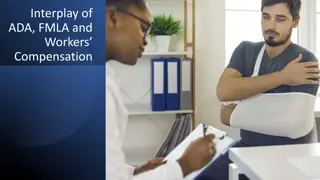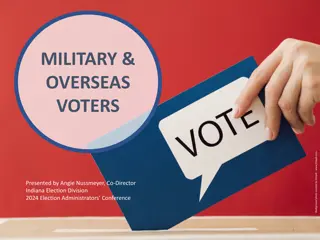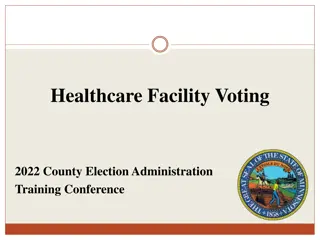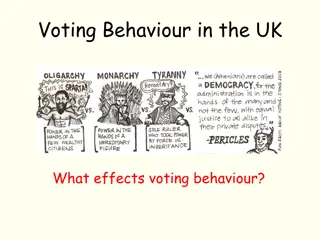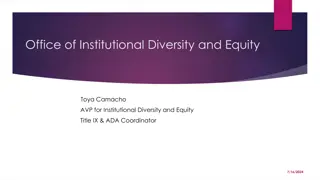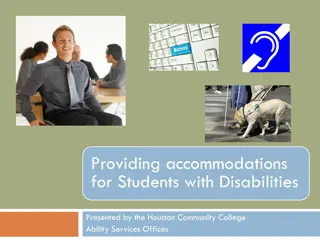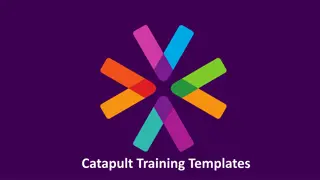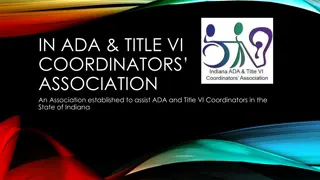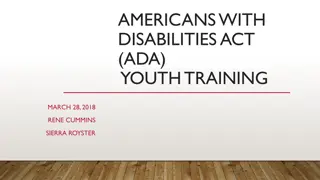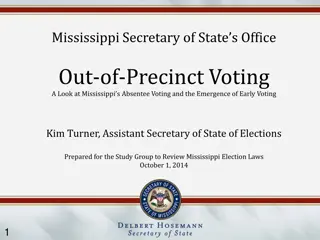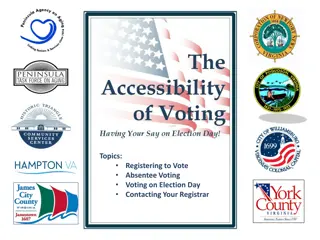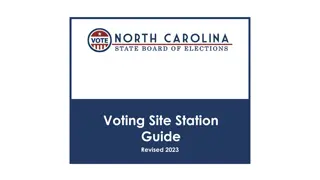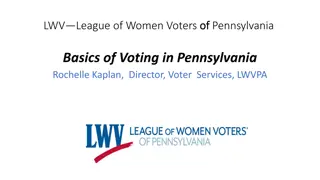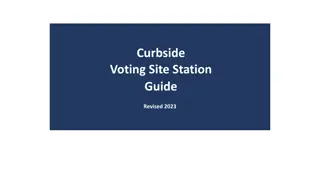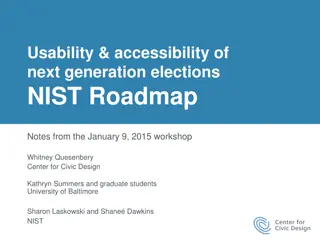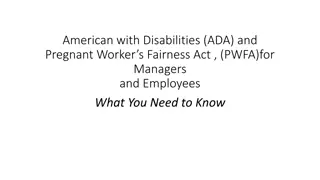ADA and Voting Workshop on August 17, 2023
Join the ADA and Voting Workshop on August 17, 2023, organized by the Tennessee Disability Coalition. Learn about the Americans with Disabilities Act (ADA), voting rights, and civic engagement resources. Explore a tailored training template and important disclaimers regarding the content presented. Enhance your understanding of ADA compliance and voting accessibility.
Download Presentation

Please find below an Image/Link to download the presentation.
The content on the website is provided AS IS for your information and personal use only. It may not be sold, licensed, or shared on other websites without obtaining consent from the author.If you encounter any issues during the download, it is possible that the publisher has removed the file from their server.
You are allowed to download the files provided on this website for personal or commercial use, subject to the condition that they are used lawfully. All files are the property of their respective owners.
The content on the website is provided AS IS for your information and personal use only. It may not be sold, licensed, or shared on other websites without obtaining consent from the author.
E N D
Presentation Transcript
Americans with Disabilities Act (ADA) and Voting Americans with Disabilities Act (ADA) and Voting Replicating Tennessee s Train Replicating Tennessee s Train- -the August 17, 2023 August 17, 2023 the- -Train Workshop Train Workshop Welcome and Introductions Donna DeStefano Assistant Executive Director Carrie Carlson Advocate and Brain Injury Specialist Tennessee Disability Coalition Purpose of Today s Webinar 1
Overview of Session 2: August 17, 2023 Overview of Session 2: August 17, 2023 Interactive session PowerPoint template of Tennessee s ADA and Voting training: Training content Civic engagement resources 2
Training Template Training Template Please remember that this is a suggested template. This presentation can be tailored and should be tailored to meet the needs of your audience. This current templet is a three-hour PowerPoint presentation. It is wise to shorten this PowerPoint if you do not have a full three hours. 3
Disclaimer Disclaimer (slide 1 of 2) (slide 1 of 2) The contents of this presentation were developed under a grant from the National Institute on Disability, Independent Living, and Rehabilitation Research (NIDILRR grant number 90DPAD0005-01-00). NIDILRR is a Center within the Administration for Community Living (ACL), Department of Health and Human Services (HHS). The contents of this publication do not necessarily represent the policy of NIDILRR, ACL, HHS, and you should not assume endorsement by the Federal Government. 4
Disclaimer Disclaimer (slide 2 of 2) (slide 2 of 2) The information, materials, and/or technical assistance provided by the Southeast ADA Center are intended solely as informal guidance and are neither a determination of your legal rights or responsibilities under the ADA, nor binding on any agency with enforcement responsibility under the ADA. The Southeast ADA Center does not warrant the accuracy of any information contained herein. Furthermore, in order to effectively provide technical assistance to all individuals and entities covered by the ADA, NIDILRR requires the Southeast ADA Center to assure confidentiality of communications between those covered and the Center. Any links to non-Southeast ADA Center information are provided as a courtesy, and are neither intended to, nor do they constitute, an endorsement of the linked materials. You should be aware that NIDILRR is not responsible for enforcement of the ADA. For more information or assistance, please contact the Southeast ADA Center via its web site at adasoutheast.org or by calling 1-800-949-4232 or 404-541-9001. 5
The ADA and Voting Train The ADA and Voting Train- -the Recap the- -Trainer Session Trainer Session Slide 1 of 3) Recap ( (Slide 1 of 3) June 16, 2022 June 16, 2022 9 am 9 am 12 pm 12 pm Presenters Donna DeStefano, Tennessee Disability Coalition Brian Keller, Tennessee Council on Developmental Disabilities Kristen Robinson, Disability Rights Tennessee Jeff Strand, Tennessee Disability Coalition 6
The Training Session The Training Session Recap Recap ( (Slide 2 of 3) Slide 2 of 3) Introductions Overview of Session ADA National Network, Southeast ADA Center ADA General Requirements Questions and Answers Voters with disabilities, turnout, impact of pandemic, civic engagement, barriers Questions and Answers 7
The Training Session The Training Session - - Recap Recap ( (Slide 3 of 3) Slide 3 of 3) Voting rights history, rights/responsibilities, polling site survey results, know your elected officials Questions and Answers Resources Questions and Answers Recap and Thank You 8
The Americans with Disabilities Act (ADA) The Americans with Disabilities Act (ADA) and Voting and Voting ADD DATE Presenter(s): Trainer name and affiliation 9
Overview of Session Overview of Session Overview of Session ADA National Network, Southeast ADA Center, ADA General Requirements Training Content Voters with disabilities, turnout, impact of pandemic, civic engagement, rights/responsibilities, barriers, resources Questions and Answers Recap and Thank You 10
Expectations for Participants Expectations for Participants Upon completion of today s ADA and Voting Train-the-Trainer, sign an agreement with YOUR ORGANIZATION committing to the following activities by DATE: Conduct one train-the-trainer session on The ADA and Voting using the training resources supplied by YOUR ORGANIZATION Complete a brief training report that includes: a. the presenter s name b. the date(s) of training c. the name of the organization or group receiving the training d. the number of attendees Training materials will be provided electronically 11
ADA National Network ADA National Network Network of ten regional ADA centers across the United States with over 2,200 affiliates at the local, state, and regional level Funded by the National Institute on Disability, Independent Living, & Rehabilitation Research (NIDILRR) Toll-Free: 1-800-949-4232 ADA National Network 12
Southeast ADA Center Southeast ADA Center Region IV Region IV A project of Burton Blatt Institute at Syracuse University Serve the eight states in the Southeast region Alabama, Florida, Georgia, Kentucky, Mississippi, North Carolina, South Carolina, Tennessee One partner organization in each state The Tennessee Disability Coalition is Tennessee s partner organization 13
Americans with Disabilities Act of 1990 Americans with Disabilities Act of 1990 Civil Rights Act Origins in the Civil Rights Act of 1964 and the Disability Rights Movement More about the ADA at U.S. Department of Justice ADA National Network 14
ADA Definition of Disability ADA Definition of Disability The ADA definition is a legal one, not a medical one. The ADA defines a person with a disability in three ways 1. a person who has a physical or mental impairment that substantially limits one or more major life activities. a person with a record of an impairment, even if he or she does not currently have a disability. a person who does not have a disability but is regarded by others as having a disability is also protected under the ADA. 2. 3. U. S. Department of Justice 15
Titles of the ADA Titles of the ADA Title I: Employment Title II: Public Services (State & Local Governments) Title III: Public Accommodations (Private Businesses) Title IV: Telecommunications Title V: Miscellaneous Provisions 16
Americans with Disabilities Act (ADA) Americans with Disabilities Act (ADA) General Requirements General Requirements Physical access Effective communication Reasonable modification of policies, practices, and procedures 17
Questions and Answers and 18
Who Are Voters with Disabilities? Who Are Voters with Disabilities? ( (Slide 1 of 4) Slide 1 of 4) Voters with disabilities are a heterogeneous group with varied preferences, capabilities or needs. US disability population: 26% - 85.3 million NOTE: Add add in data from your state here. The US population of individuals with disabilities is growing US estimate in 2040 - 94.7 million Rutgers School of Management and Labor Relations 19
Who Are Voters with Disabilities? Who Are Voters with Disabilities? ( (Slide 2 of 4) Slide 2 of 4) The US population is also aging 2020 YOUR STATE population 2040 YOUR STATE population Voters with disabilities face a voter turnout gap as a result of barriers to voting. 2018, the turnout gap in the United States was 4.7% YOUR STATE, that gap was X%. Rutgers School of Management and Labor Relations 20
Who Are Voters with Disabilities? Who Are Voters with Disabilities? ( (Slide 3 of 4) Slide 3 of 4) Of those voters with disabilities that did cast a ballot: More than 30% said they experienced difficulty doing so. 40% of non-voters with disabilities said they expected difficulties and chose not to vote because of them. Rutgers School of Management and Labor Relations 21
Who Are Voters with Disabilities? Who Are Voters with Disabilities? ( (Slide 4 of 4) Slide 4 of 4) Voters with disabilities show higher levels of political interest. In 2018, voters with disabilities were more likely to think about politics, follow campaigns closely and believe that the outcome really matters, and less likely to forego casting a vote because of disinterest. Voters with disabilities show higher interest in politics but have lower turnout voter turnout rates. Rutgers School of Management and Labor Relations 22
Disability & Voter Turnout Data Disability & Voter Turnout Data National ( (Slide 1 of 2) Slide 1 of 2) If people with disabilities voted at the same rate as people without disabilities who have the same demographic characteristics, there would be about 1.75 million more voters. National Voter turnout among citizens with disabilities in 2020 increased by 5.9 points relative to the 2016 general election. The turnout gap between people with and without disabilities decreased slightly in 2016-2020 from 6.3 to 5.7 points. U. S. Election Assistance Commission and Rutgers Study on Disability and Voting Accessibility in the 2020 Elections 23
Disability & Voter Turnout Data Disability & Voter Turnout Data National ( (Slide 2 of 2) Slide 2 of 2) National The increased turnout among people with disabilities occurred across all disability types and demographic categories gender, race/ethnicity, age group, and region. Employed people with disabilities were just as likely as employed people without disabilities to vote in 2020 Voting by mail increased during the pandemic for people both with and without disabilities, and voters with disabilities continued to be more likely to use this option. U. S. Election Assistance Commission and Rutgers Study on Disability and Voting Accessibility in the 2020 Elections 24
The State of the Disability Vote The State of the Disability Vote Impact of the Pandemic Impact of the Pandemic ( (Slide 1 of 2) Slide 1 of 2) Mail-in ballots States that implemented no-excuse mail-in voting: +7.8% States that made no changes to mail-in voting: +6.3% +152,600 voters with disabilities in states that implemented no-excuse mail-in voting Drop boxes States that provided drop boxes for mail-in ballots: +7.2% States without drop boxes: +5.9% +274,400 voters with disabilities in states with drop boxes U. S. Election Assistance Commission and Rutgers Study on Disability and Voting Accessibility in the 2020 Elections 25
The State of the Disability Vote The State of the Disability Vote Impact of the Pandemic Impact of the Pandemic ( (Slide 2 of 2) Slide 2 of 2) Extended early voting States with extended early voting: +10.1% States making no change to early voting: +6.7% +123,100 voters with disabilities in states with extended early voting Extended registration deadlines States with extended registration deadlines: +10.5% States without extended registration deadlines: +6.6% +120,400 voters with disabilities in states with extended registration deadlines U. S. Election Assistance Commission and Rutgers Study on Disability and Voting Accessibility in the 2020 Elections 26
Barriers to Voting Barriers to Voting - - Accessibility Accessibility Physical accessibility of polling places 2016 - 17% of polling places were fully ADA accessible Availability of accessible voting machines Voters with disabilities were 8 times more likely to have difficulty understanding how to use the machine s features Voters with disabilities were 15 times more likely to have difficulty operating the voting machine than voters without disabilities. Poll worker shortage In 2012, 27% of surveyed voters with disabilities found poll workers unable to set up or operate voting machine accessibility features and 44% found poll workers ignorant or awkward when interacting with voters with disabilities. U. S. Election Assistance Commission and Rutgers Study on Disability and Voting Accessibility in the 2020 Elections and GAO Report VOTERS WITH DISABILITIES 27
Barriers to Voting Barriers to Voting - - Systemic Barriers ( (Slide 1 of 2) Slide 1 of 2) Systemic Barriers Strict photo ID laws ~10% of voters with disabilities nationwide do not have a valid photo ID. Voter registration purging People with disabilities have higher mobility rates (requiring more frequent re-registering) and face more obstacles to returning purge notices. U. S. Election Assistance Commission and Rutgers Study on Disability and Voting Accessibility in the 2020 Elections and Voting is already hard for people with disabilities. Voter ID laws make it even harder. 28
Barriers to Voting Barriers to Voting - - Systemic Barriers ( (Slide 2 of 2) Slide 2 of 2) Systemic Barriers Transportation Voters with disabilities are almost 4 times more likely than those without disabilities to cite transportation problems as their primary reason they chose not to vote. Guardianship laws NOTE: If applicable include your state information here (Guardianship and Voting) U. S. Election Assistance Commission and Rutgers Study on Disability and Voting Accessibility in the 2020 Elections and Guardianship and Voting 29
Civic Engagement Civic Engagement (Slide 1 of 2) (Slide 1 of 2) Civic engagement must be an essential element of democratic practice if government is ever to be of the people, by the people, for the people. Civic Engagement & People with Disabilities: A Way Forward through Cross-Movement Building- Brandeis Civic engagement is an important way to deliver power to the community, which takes place in environments made up of diverse people, practices, conditions, and values. Disability Civic Engagement Guide -ABLE-SC and Southeast ADA Center 30
Civic Engagement Civic Engagement ( (Slide 2 of 2) Slide 2 of 2) Citizens who are engaged in their community: Become informed about issues Reading Discussing with others Take action Individually or in a group Making your voice heard 31
Barriers to Civic Engagement Barriers to Civic Engagement Three principal barriers to civic engagement for people with disabilities: 1. Social stigma and ableism 2. Discrete networks and lack of intentional overlap of civic engagement and disability rights ecosystems 3. Lack of inclusion of disability rights within the work of civic engagement organizations and movements Civic Engagement and People with Disabilities: A Way Forward through Cross-Movement Building 32
Questions and Answers and 33
Voting Rights Voting Rights Constitutional Amendments Constitutional Amendments Article 1 of the Constitution gave states the responsibility of overseeing federal elections. Constitutional Amendments Affecting Voting Rights The 15th Amendment gave African American men the right to vote in 1870. However, some states used literacy tests and other barriers to make it harder to vote. The 19th Amendment, ratified in 1920, gave American women the right to vote. The 24th Amendment, ratified in 1964, eliminated poll taxes. The tax had been used in some states to keep African Americans from voting in federal elections. The 26th Amendment, ratified in 1971, lowered the voting age to 18 for all elections. 34
Federal Voting Rights Laws Federal Voting Rights Laws (Slide 1 of 2) (Slide 1 of 2) The first protection was the Civil Rights Act of 1870 Enforced the terms of the 15th Amendment Prohibited the states from denying anyone the right to vote based on race 35
Federal Voting Rights Laws Federal Voting Rights Laws ( (Slide 2 of 2) Slide 2 of 2) The 1870 Act was followed by: The Civil Rights Acts of 1957, 1960, 1964 which amended the 1870 Act protections The Voting Rights Act of 1965 The Voting Accessibility for the Elderly and Handicapped Act of 1984 The Uniformed and Overseas Citizens Absentee Voting Act of 1986 The National Voter Registration Act of 1993 The Help America Vote Act of 2002 The Military and Overseas Voting Empowerment Act of 2009 36
State Voting Rights Laws State Voting Rights Laws Voter ID Laws Two-thirds of states require you to show some form of identification before you re allowed to vote. More about states voter ID requirements on the usa.gov site. 37
Americans with Disabilities Act (ADA) Americans with Disabilities Act (ADA) and Other Federal Laws and Other Federal Laws Protecting the Rights of Voters with Disabilities The Americans with Disabilities Act (ADA) The Voting Rights Act of 1965 (VRA) The Voting Accessibility for the Elderly and Handicapped Act of 1984 (VAEHA) The National Voter Registration Act of 1993 (NVRA) The Help America Vote Act of 2002 (HAVA) 38
Americans with Disabilities Act (ADA) Americans with Disabilities Act (ADA) Voting Rights Voting Rights Protecting the Rights of Voters with Disabilities ( (Slide 1 of 5) Slide 1 of 5) The Americans with Disabilities Act of 1990 (ADA): Requires state and local governments ( public entities ) to ensure that people with disabilities have a full and equal opportunity to vote. This applies to all aspects of voting, including voter registration, site selection, and the casting of ballots. 39
Americans with Disabilities Act (ADA) Americans with Disabilities Act (ADA) Voting Rights Voting Rights Protecting the Rights of Voters with Disabilities (Slide 2 of 5) (Slide 2 of 5) Requirements at Polling Sites Parking Accessible Routes Ramps Protruding Objects Building Entrance Lifts and elevators Voting Area Early Voting 40
Americans with Disabilities Act (ADA) Americans with Disabilities Act (ADA) Voting Rights Voting Rights Protecting the Rights of Voters with Disabilities (Slide 3 of 5) (Slide 3 of 5) Disability Rights Tennessee Poll Site Surveys Barrier: Accessible route to entrance does not have a path of travel; has gravel, then wet dirt leading to a grassy area ADA Checklist for Polling Places 2016 ADA Checklist for Polling Places 2016 41
Americans with Disabilities Act (ADA) Americans with Disabilities Act (ADA) Voting Rights Voting Rights Protecting the Rights of Voters with Disabilities (Slide 4 of 5) (Slide 4 of 5) Disability Rights Tennessee Poll Site Surveys Barrier: Door hardware not accessible to open door ADA Checklist for Polling Places 2016 ADA Checklist for Polling Places 2016 42
Americans with Disabilities Act (ADA) Americans with Disabilities Act (ADA) Voting Rights Voting Rights Protecting the Rights of Voters with Disabilities (Slide 5 of 5) (Slide 5 of 5) Disability Rights Tennessee Poll Site Surveys Barrier: Accessible entrance has stairs leading to door ADA Checklist for Polling Places 2016 ADA Checklist for Polling Places 2016 43
Know Your Voting Rights Know Your Voting Rights I do not have to prove my IQ or my ability to read and write to vote. Only a court can take away this right. I may vote even if I have a conservator, unless a court has explicitly said I cannot. If I need help to vote, I do not have to explain why. I can have someone I choose or a poll worker help me vote if I ask. I may ask for an accessible voting machine if I need one. Every polling place is required by law to have one. 44
Tennessee Bill of Voting Rights Tennessee Bill of Voting Rights (Slide 1 of 4) (Slide 1 of 4) The constitution of the United States of America states that I have the right to take part in my civic life. If I am registered to vote in Tennessee, I have the right to vote in this election. I have the right to vote by myself or with help. I can select who I want to assist me. Even if I have a conservator, I may vote unless a court specifically said I cannot. 45
Tennessee Bill of Voting Rights Tennessee Bill of Voting Rights (Slide 2 of 4) (Slide 2 of 4) I have the right to vote the way I want. I have the right to get help if someone tries to stop me from voting. I have the right to be shown how to make my choices at the ballot. If I am waiting in line when the poll closes, I must be allowed to vote. 46
Tennessee Bill of Voting Rights Tennessee Bill of Voting Rights (Slide 3 of 4) (Slide 3 of 4) If I am prevented from voting, I may stay at the polling site and call for help from one of the following: Disability Rights Tennessee Voting Assistance Hotline *Available for on-the-spot advocacy assistance during Early Voting and Election Day Call: 800-342-1660 Email: GetHelp@disabilityrightstn.org 47
Tennessee Bill of Voting Rights Tennessee Bill of Voting Rights (Slide 4 of 4) (Slide 4 of 4) For other voting accessibility or voting rights concerns, contact the number below: Tennessee State Coordinator of Elections 877-850-4959 48
Exercising Your Right to Vote Exercising Your Right to Vote Example from Tennessee Example from Tennessee GoVote TN A portal for Tennesseans to access election information. Maintained by the Tennessee Secretary of State's Division of Elections. GoVoteTN App Tennessee Online Voter Registration System 49
Exercising Your Right to Vote Exercising Your Right to Vote Get to Know Your Elected Officials Get to Know Your Elected Officials Federal Congress Find Your Members State YOUR STATE and LINKS Add links for YOUR STATE Local Find your local government officials council/commission members, school board 50



